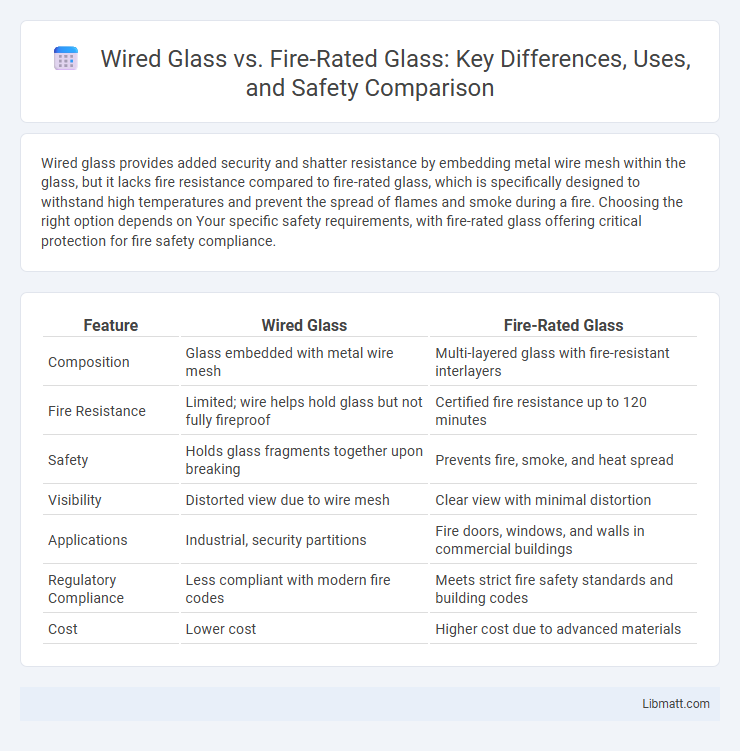Wired glass provides added security and shatter resistance by embedding metal wire mesh within the glass, but it lacks fire resistance compared to fire-rated glass, which is specifically designed to withstand high temperatures and prevent the spread of flames and smoke during a fire. Choosing the right option depends on Your specific safety requirements, with fire-rated glass offering critical protection for fire safety compliance.
Table of Comparison
| Feature | Wired Glass | Fire-Rated Glass |
|---|---|---|
| Composition | Glass embedded with metal wire mesh | Multi-layered glass with fire-resistant interlayers |
| Fire Resistance | Limited; wire helps hold glass but not fully fireproof | Certified fire resistance up to 120 minutes |
| Safety | Holds glass fragments together upon breaking | Prevents fire, smoke, and heat spread |
| Visibility | Distorted view due to wire mesh | Clear view with minimal distortion |
| Applications | Industrial, security partitions | Fire doors, windows, and walls in commercial buildings |
| Regulatory Compliance | Less compliant with modern fire codes | Meets strict fire safety standards and building codes |
| Cost | Lower cost | Higher cost due to advanced materials |
Introduction to Wired Glass and Fire-Rated Glass
Wired glass features a metal mesh embedded within the glass, providing enhanced safety by holding shards together during breakage, while fire-rated glass is specifically designed to withstand high temperatures and prevent the spread of fire and smoke. Fire-rated glass undergoes rigorous testing to meet fire resistance standards, offering critical protection in fire emergency situations. Your choice between wired glass and fire-rated glass depends on the balance between safety, fire resistance, and building code requirements.
What is Wired Glass?
Wired glass is a type of safety glass embedded with a mesh of thin metal wires, enhancing its strength and resistance to impacts and heat. This specialized glass is commonly used in fire-rated doors and windows to prevent the spread of flames while maintaining visibility. When considering your building's fire safety, wired glass provides a durable option that complies with fire code requirements but may have limitations in thermal performance compared to modern fire-rated glass alternatives.
What is Fire-Rated Glass?
Fire-rated glass is specially designed to withstand extreme heat and prevent the spread of fire and smoke for a designated period, typically ranging from 20 minutes to several hours. Unlike traditional wired glass, which contains a metal mesh for added security but doesn't offer significant fire resistance, fire-rated glass incorporates multiple layers or specialized coatings to maintain integrity during a fire. Your choice of fire-rated glass enhances safety by meeting strict building codes and fire protection standards while allowing natural light to pass through.
Key Differences: Wired Glass vs Fire-Rated Glass
Wired glass incorporates a metal mesh embedded within the glass, providing enhanced shatter resistance and preventing large shards during impact, primarily used for safety and security applications. Fire-rated glass is engineered to withstand high temperatures and prevent the spread of flames and smoke, meeting stringent fire protection standards for escape routes and fire barriers. Your choice depends on whether the priority is physical impact resistance or certified fire protection performance.
Safety and Security Considerations
Wired glass offers enhanced safety by preventing shattering due to its embedded wire mesh, but its limited thermal resistance makes it less effective in fire-rated applications compared to fire-rated glass. Fire-rated glass provides superior security and protection by withstanding high temperatures and flames for specified durations, helping to contain fires and protect occupants. Your choice should prioritize fire-rated glass for stringent fire safety standards, while wired glass may be suitable for applications emphasizing impact resistance without high fire exposure.
Applications and Use Cases
Wired glass is commonly used in institutional settings such as schools and hospitals for its ability to maintain security while allowing visibility and light transmission. Fire-rated glass is designed for use in fire doors, windows, and partitions within commercial buildings, providing fire resistance along with safety in egress routes. Your choice depends on whether the priority is security and shatter-resistance (wired glass) or certified fire protection and containment (fire-rated glass).
Building Codes and Regulations
Building codes and regulations often dictate specific requirements for fire-rated glass to ensure safety and compliance in commercial and residential construction. Wired glass, while traditionally used for fire resistance, is increasingly being replaced by modern fire-rated glass that meets higher standards for impact resistance and clarity under codes such as NFPA 80 and IBC. Understanding these regulations helps you select the appropriate material to maintain code compliance and enhance building safety.
Pros and Cons of Wired Glass
Wired glass offers enhanced safety by holding shattered glass pieces together during impact, reducing the risk of injury, and provides good fire resistance due to embedded metal wire mesh that slows heat transmission. However, it tends to have lower visual clarity and can weaken the glass's structural integrity under extreme heat compared to fire-rated glass, which typically maintains strength and optical quality better. Your choice depends on balancing cost, safety standards, and aesthetic preferences in applications requiring fire safety glazing.
Pros and Cons of Fire-Rated Glass
Fire-rated glass offers excellent fire resistance, providing up to 120 minutes of protection while maintaining clear visibility and modern design appeal. Its major advantage includes enhanced safety without compromising aesthetics or natural light, but it tends to be more expensive and heavier than traditional wired glass. However, fire-rated glass can be more fragile under impact and may require specialized installation and maintenance compared to wired glass.
Choosing the Right Glass for Your Project
Choosing the right glass for your project depends on safety requirements and design preferences, where fire-rated glass provides superior heat resistance and fire containment compared to wired glass. Wired glass contains a metal mesh for impact resistance but may fail under high heat, making it less ideal for fire-rated applications. Your decision should prioritize fire code compliance and performance specifications relevant to the building's fire safety plan.
wired glass vs fire-rated glass Infographic

 libmatt.com
libmatt.com